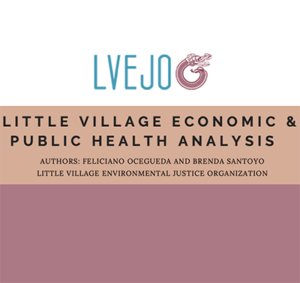The South Lawndale community has been heavily impacted by the COVID-19 pandemic. With case numbers and deaths that rank among the highest in the City of Chicago, residents of South Lawndale have faced the negative effects of pandemic as an exacerbation of existing economic and public health inequities.
To better understand and address these inequities, this report aims to identify both the key issues faced by residents on these fronts and delineate the policy implications. The successes and shortcomings of policies enacted during the pandemic can serve as data points for future advocacy efforts.
 January 2022 Download Full Report |
|---|
Select Excerpts
Public Health
The 60623 ZIP Code, which includes the neighborhood of Little Village, has consistently reported some of the highest COVID-19 rates in the City of Chicago throughout the course of the pandemic.
As of January 15th, there have been a total of 299 reported COVID deaths and 17,915 (1 in 5) total cases reported in the ZIP Code area. (COVID-19 Cases, Tests, and Deaths by ZIP Code, 2022). These numbers fall in line with larger national trends of the pandemic’s disproportionate impact on Black and Brown communities (Khanijahani et al., 2021; Mude et al., 2021). The Associated Press reported that 30% of Black Americans and 29% of Hispanic Americans surveyed had someone close to them, either a friend or family member, die of COVID-19, two times more likely than white Americans (Morrison, Stafford, & Swanson, 2021).
(Download the full report to read more…)
Economics
In 2015, Little Village’s 26th Street corridor was named the second highest-grossing commercial strip in Chicago following the Magnificent Mile. The commercial strip consists of roughly 500 businesses – most small family-run shops – within a two- mile radius (Silets, 2015). With 17,000 people living per square mile, it is one of the most densely populated neighborhoods in the city, allowing the area to have immense purchasing power. The rich Mexican culture and vibrant community of the Little Village neighborhood area attract people from all over to shop in its commercial strip which helps drive its significant revenue earnings. The Little Village economy also uniquely consists of many individuals employed in the informal economy. This unregulated economic sector refers to cash-based self- employment, including jobs like babysitting, street vending, house repairs, etc. often taken on by individuals whose social circumstances such as documentation status, criminal records, or low levels of education do not allow them to be employed in the formal economy (Raijman, 2001). The distinctive qualities of the Little Village commercial corridor and economic sector allow the community the opportunity to build wealth through its cultural and social capital. […]
Post-Pandemic Resiliency and Recovery
What this pandemic has taught us is that there is a need for robust policy efforts that need to address the necessities of often underrepresented vulnerable populations. Informal workers like street vendors contribute to what makes Little Village so rich in culture and capital, but did not have adequate support through the duration of the peak of the pandemic. Small businesses in Black and Brown communities struggled to attain federal assistance for economic relief throughout the country due to disparities in banking and barriers in language, technology, and access to information. Undocumented families struggled to attain federal assistance and the resources available to these families was not sufficient to sustain the need. There is a need to re-envision policies to ethically and equitably distribute resources to those who are structurally most vulnerable to financial hardship.
Conclusion
The impact of the COVID-19 pandemic on South Lawndale has been colored by the existing economic and health inequities that existed prior to the public health emergency. While South Lawndale boasts a large, successful commercial corridor along 26th Street, the many residents who work in the informal economy, lack banking services, or lack documentation status faced decreased economic security during the pandemic. Alongside the increased unemployment and lack of access to city and federal aid, the importance of building cultural and social capital in the community has never been more evident. While the need still exists for the City of Chicago to do more for residents facing economic challenges with continued spread of COVID-19, the efforts of mutual aid groups such as Farm, Food, Familias point towards community building that can increase resiliency to neighborhood shocks post-pandemic.
As well as highlighting the need for community investment, the pandemic exacerbated the issues with access to care that South Lawndale residents face. Connecting uninsured community members to primary care providers in the short- term can decrease vaccine hesitancy, while in the long-term it could help treat and prevent other ailments residents face. Expansion of existing policies and programs, such as more healthcare coverage for undocumented residents through the State and vaccine canvassing through the City, stand out as potentially impactful for community members. South Lawndale has much to gain from needed investments in social and physical infrastructure, from health clinics to new Lead Service Lines. The post-pandemic future charted by the City of Chicago, State of Illinois, and federal government must include a vision for a more economically secure, resilient, and healthy environment for South Lawndale residents.
(Download the full report to read more…)
